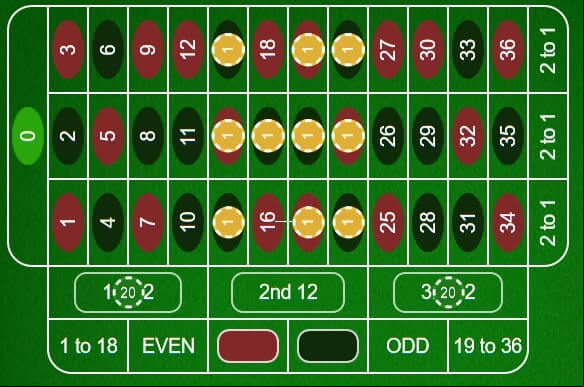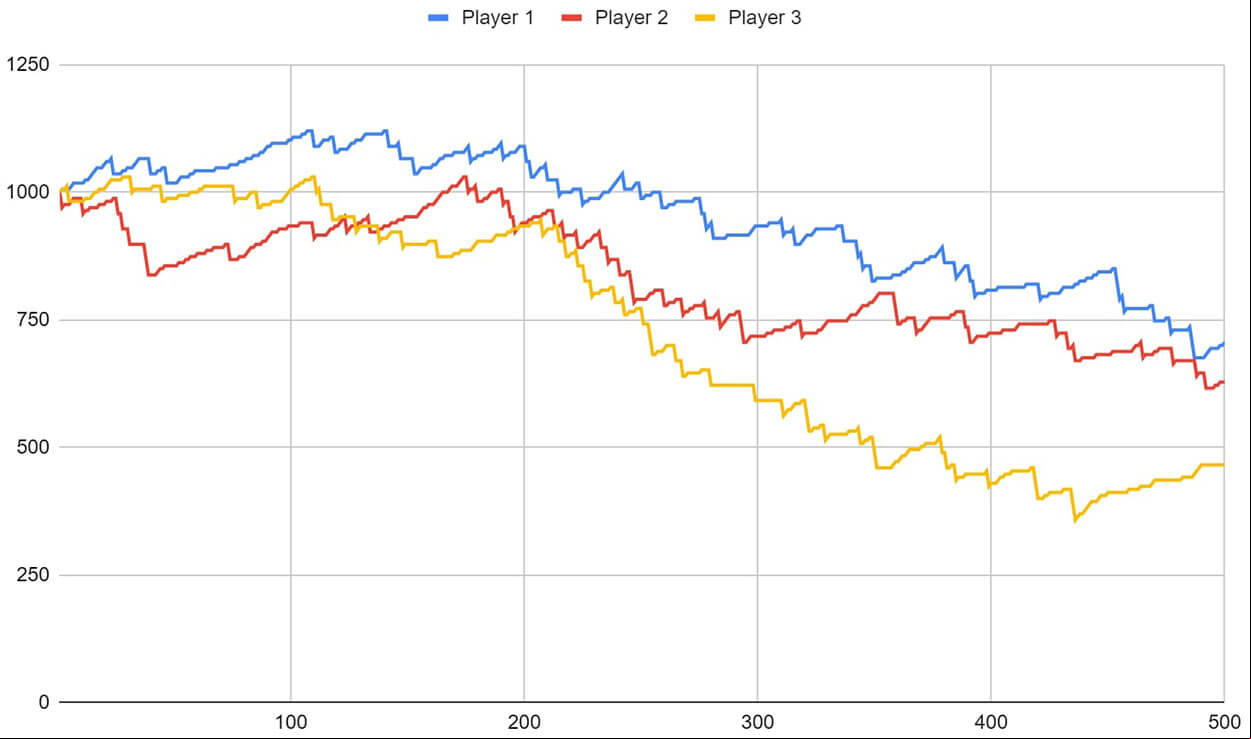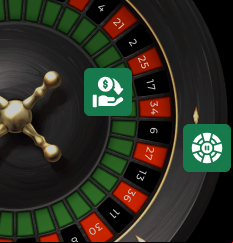How to Work the 24+8 System
As its name suggests already, you are basically betting on the Dozens and then just betting straight-up bets on the rest. So, what is happening here is that you are going to bet AU$ 10 on any of the three Dozens columns available. After you do that, you will go and pick 10 bets from the table and place a single AU$ 1 bet on each. This will give you a very solid chance of winning of about 91.89% as we have covered 34 out of the 37 possible combinations – this is really solid.
So, what happens if we lose during a round of 24+8? Well, there is nothing you can do, but you can always follow the system, which is precisely what we will be doing here as well. If you lose, just double the numbers as when playing the classic Martingale, and that is it.

On this graph, you can see that the first and third Dozens bets are covered, so the numbers from 1-12 and 25-36. The next thing the player has done is to place wagers of AU$ 1 each on 13, 14, 15, 16, 17, 18, 19, 21, and 24. The only remaining uncovered bets here are 22, 25 and the zero.
There are three possible things that could happen based on what we have just bet, and we will now break them down for you:
- One of the Dozens Wins: In this case, we have a 64.86% chance of winning – if we do, this is a push and we have won AU$ 30, but bet/lost AU$ 30 as well
- One Straight Bet Wins: Here, the result is AU$ 6 of net gain when ing for all the other losses – the chance of a straight-up bet win is 27.03%
- None of Our Numbers Win: We clock in a AU$ 30 loss
Next, we want to find out what would happen over several spins and rounds and see if this system is actually any helpful. Let’s take a look:
- Spins 1
We win on one of our Dozens – this is a push
- Spins 2
One of our straight-up bets wins next
- Spins 3
We win one of our Dozens again. We are still up AU$ 6
- Spins 4
We win another straight-up bet and are up AU$ 12
- Spins 5
We lose AU$ 30, and we end up with an AU$ 18 net loss – we double the next spin amount
What the Tests of 24+8 Returned?
Not least, we set out to test the system ourselves. We were confident that tutorials enough would not suffice, so we decided to actually run a simulation of five players using Google Docs. Our simulation was very straightforward and therefore, the results are similarly easy to interpret and comprehend. Basically, we had five players with a AU$ 1,000 bankroll each and 1000 rounds, using the 24+8 system. Here is what happened:

So, a quick look at the first graph will tell us a lot about what to expect from the 24+8 system and its returns. It’s not surprising that the bankroll using this system took a nosedive on more than a few occasions. Player 3 managed to top AU$ 1,060 after the 55th round, which was his peak performance, but he ended up the session with a AU$ 288 loss instead.
A trend emerged where players were suffering sharp declines past a certain stage in the progression. The results we discovered during our tests are more or less attributable to Martingale. But like Martingale, the 24+8 system is trying to compensate for losses by progressing further up and doubling the amounts wagered.
This way, the logic goes, we will eventually be able to break even – unless you run out of bankroll or reach the table’s limit, which makes it impossible to recoup bigger losses. Alright, so we can tell for sure that this progression is not great. Instead of doubling, though, we are going to alter the system.
We are going to bet the same base amount on 24+8 every round – win or lose. We tested this with a AU$ 1,000 bankroll and 500 rounds.

As we can tell, the medication did mitigate some of the precipitous losses, but players did end up losing money all the same. The three players we tested still lost money. What was different here was that the losses accumulated slowly, but so did the winnings. It’s a good example of how you can modify a roulette system and decide whether it works for you.
What Are the Dangers of 24+8 Roulette System
As you can see, the system is definitely tempting and it does apply some basic logic to the game of roulette. It makes a lot of sense to use it on occasion, but as our extensive testing has concluded, there are dangers related to how sustainable it is over the long term. With this being said, you may want to run 24+8 roulette systems in the short term instead, and hope to win a small profit on top. As soon as you do, however, you may want to move onto another strategy instead.
Conclusion
The above tests are a good example of what a 24+8 roulette system is and how it works. Players who are new to the system may notice that it borrows from the Martingale System in doubling every successive loss and hoping to retrieve it. The fact you will bet a lot more units at once here, though, means that Australian players need to be mindful of this strategy as it can progress beyond the table limit very quickly.
We similarly run the same system tests while factoring in the Martingale System and removing it from the equation. In this case, we observed that 24+8 roulette system did very well in the sense that it did not cause us to lose money too quickly. The drawback is that in the end of our testing – the system once again failed to produce meaningful, i.e. profitable, results in the long-term. With all of this in mind, we can definitely draw several conclusions to begin with.
First, 24+8 is an interesting roulette system that can be applied with ease and does not take any specialist knowledge to do so. However, there is one big caveat that players need to be aware here before they spend more time with this system. It’s prone to rapid swings and it can lock you out of betting due to table limits.
That is why we recommend using this system only if you are perfectly aware of what it holds and how to address it. Do not use this strategy in the long term and try to keep a cool head when you bet on 24+8 system, realizing that it’s one of the riskier options on the market for you.















